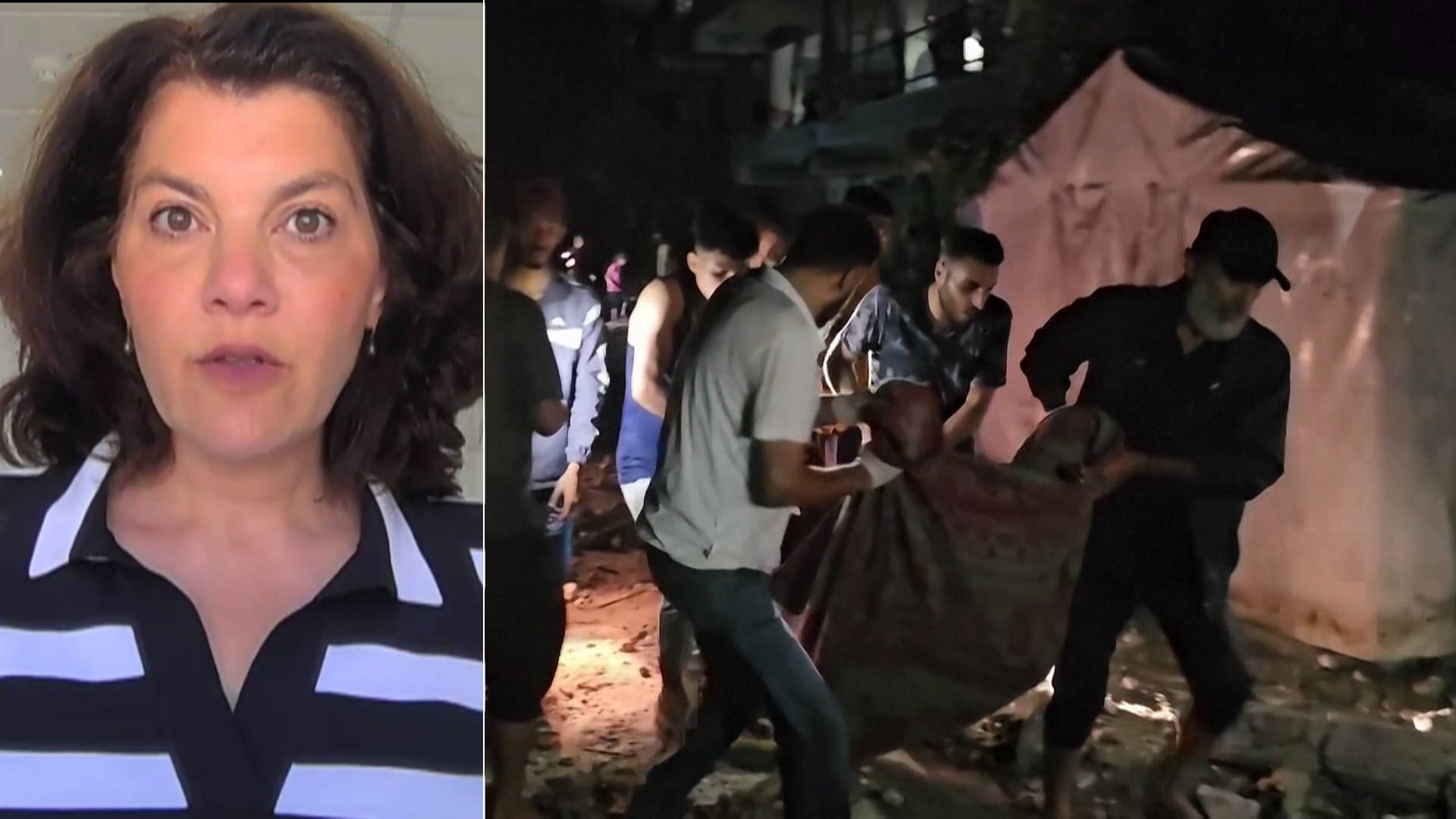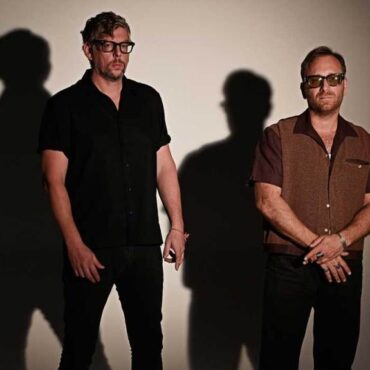This is a rush transcript. Copy may not be in its final form.
AMY GOODMAN: An Israeli airstrike on a school sheltering displaced Palestinians in the Nuseirat refugee camp in central Gaza has killed at least 40 people, including 14 children, according to the government media office in Gaza. Nearly 80 Palestinians were also wounded in the predawn strike on the Al-Sardi School, which is run by the United Nations agency for Palestinian refugees, known by its acronym UNRWA. The Israeli military claimed it targeted Hamas militants operating in the school, but provided no evidence to back up its claim.
UNRWA schools across Gaza have functioned as shelters for displaced Palestinians since the start of Israel’s war on Gaza. Last week, Israeli airstrikes hit close to an UNRWA facility in the southern city of Rafah, where tens of thousands had sought shelter, setting tents ablaze and killing at least 45 people. Over 36,600 people have been killed in Israeli military air attacks in Gaza over the past eight months, with over 83,300 injured.
For more, we’re joined by UNRWA spokesperson Tamara Alrifai. She joins us from Amman, Jordan.
Welcome back to Democracy Now!, Tamara. Can you explain what happened at about — what was it? About 1:30 in the morning Gaza time.
TAMARA ALRIFAI: Yes. Hi, Amy, and thank you so much for giving UNRWA always a space and a platform on Democracy Now!
What we understood from our colleagues in Gaza, given how patchy telecommunication is, is that, indeed, an Israeli strike hit one of our shelters. Originally, this was a school, but since the beginning of the war, this school in Nuseirat in the middle part of Gaza, like many, many other UNRWA schools across the Gaza Strip, have housed people who have been repeatedly displaced as the conflict in Gaza evolved, evicting them and forcing them to leave their homes, leave loved ones and leave their things behind. The strike happened around 2 a.m. And from what we understand, there are between 35 and 45 people killed. Many of them are children.
We also remind that this being an UNRWA shelter, up to 6,000 people had sought refuge and safety inside that school, just like many, many other displaced people of the 2 million population of Gaza have been seeking a safe haven — but it hasn’t been safe — inside UNRWA shelters. I say that it’s not safe, because more than 170 UNRWA buildings, most of them serving as shelters, have been hit since the beginning of the war, killing more than 450 people. And by the way, we have lost — UNRWA has lost so far 193 of my colleagues, all of them killed since the beginning of this war.
AMY GOODMAN: I wanted to go to a post on social media where Israeli military spokesperson Peter Lerner said Israel intentionally targeted the school, and wrote, quote, “We assess that: 20-30 terrorists were in the compound at the time of the strike. We targeted: Precision strikes on the specific classrooms. What were the terrorists doing in a @UN school: The compound was used for staging attacks and as a forward operating base,” end-quote. Your response, Tamara?
TAMARA ALRIFAI: We had 6,000 people, who had been displaced several times since the war started in October, sheltering in our schools. Most of them, more than half of them, were women and children. We’ve been hearing about precision strikes and about reports that some of the UNRWA or U.N. installations have been used by Palestinian armed groups. We hear about this every time a strike kills scores of civilians in or near our buildings. International law is clear. International humanitarian law calls for the protection of civilians, of people, of women, of children. During this conflict, the U.N. has paid the highest toll ever in such a short period. Eight months is not short, but 193 UNRWA staff killed and 450 people in our shelters is huge.
AMY GOODMAN: And what happened in Rafah last week with the Israeli airstrike, that the Israeli military did not deny, that led to the deaths of 45, at least, Palestinians who were in this tent camp, who had fled there because they were told that this area would be safe?
TAMARA ALRIFAI: Exactly what you’re saying, Amy. Since the beginning of this war, Gazans have been issued what the Israeli government calls evacuation orders. In reality, these are orders for forced displacement. So, this sea of people in Gaza has moved since the beginning of the conflict from the north of the Gaza Strip or Gaza City to the middle areas, Khan Younis, Deir al-Balah and Khan Younis, and then they were forced to move again, in the direction of the conflict, to Rafah, where people were told that they would be safe. Until last month, Rafah housed 1.5 million people, all of them displaced several times, and all of them were told that if you go to Rafah, you would be safe.
Then, as of the 6th of May, the Israeli government decided on a land, ground invasion of Rafah, therefore pushing people to move again. Many of them had nowhere left to go. The tents became very, very rare in Rafah. No one had personal belongings. But mostly, there was nowhere safe, because strikes continues, aerial bombings continued. So, there was nowhere safe. There still is nowhere safe. And what happened to these people in the tents is apocalyptic, like my colleagues from MSF say, and a reminder that nowhere is safe in Gaza.
AMY GOODMAN: The issue of hunger. The U.N. World Food Programme has issued a dire warning, stating, quote, “Over one million people — half the population of Gaza — are expected to face death and starvation by mid-July” if the war doesn’t end. If you can talk about what UNRWA has been able to do in helping to relieve the suffering, given how many countries have pulled out of funding of UNRWA because Israel said that UNRWA, some of the workers, had been tied to the October 7th attack, though not presenting any evidence, leading to a number of countries restoring funding to UNRWA, though the U.S. hasn’t?
TAMARA ALRIFAI: So, let’s start with the good news. All of the 16 countries that had suspended funding resumed funding to UNRWA, except the U.S. and the U.K.. The U.S. and the U.K., though, are big donors to UNRWA, so that leaves us with a huge funding gap. Having said that, we’ve been receiving a lot of support from private individuals, private foundations, celebrities, in a sign of acknowledgment of the irreplaceable role that UNRWA has been playing since the beginning of the conflict.
UNRWA is the largest humanitarian operation. We also cooperate very closely with other U.N. agencies, particularly the World Food Programme, on distributing food. The distribution of food, of wheat flour, of clean drinking water has not stopped since the beginning of the war, despite extremely challenging humanitarian circumstances, that include very, very patchy opening of the crossings, the land crossings, whether it’s Rafah from the Egyptian side or Karem Abu Salem, Kerem Shalom, from the side of Israel. Land crossings are the safest and the fastest ways to get aid into the Gaza Strip. We’ve all been discussing for the longest time how many trucks a day have gone in. I want to say that the last month has been awful. Most of the days in May have seen zero trucks going in for the U.N., and on the best day, we’ve seen 77 trucks — 77 trucks with food, nonfood, mattresses, tents, clean water, medicines, medical supplies for a population of nearly 2 million people, or a bit over 2 million, completely under siege since the latest military operation started in the May.
So, yes, UNRWA has long warned from malnutrition and an imminent famine. UNICEF just recently said that nine out of 10 children in Gaza fall way below their needed calorie intake daily. And now with the scorching heat of nearly 90 degrees Fahrenheit in Gaza, lack of clean drinking water, we have started to see infants dying of dehydration.
AMY GOODMAN: Finally, this breaking news, the United States and 16 other countries calling on Israel and Hamas to accept the latest ceasefire-hostage deal, not clear exactly what the details are. What would this mean in Gaza right now?
TAMARA ALRIFAI: A ceasefire is what everyone in Gaza needs right now, just to take a breath and have some respite. But in addition to the ceasefire, there has to be a much increased flow of humanitarian assistance going in, and there has to be a plan to resume some sense of normality in the Gaza Strip, particularly for traumatized children. And for that, a resumption of any kind of learning will help the children, not only lagged behind, but it will also help restore some kind of mental well-being. A ceasefire is what everyone needs in Gaza now.
AMY GOODMAN: Tamara Alrifai, we want to thank you for being with us, spokesperson for UNRWA, the United Nations agency for Palestine refugees, speaking to us from Amman, Jordan.
Next up, Where Olive Trees Weep, a new film on Palestinian life under Israeli occupation. We’ll be joined by the acclaimed Canadian physician, Dr. Gabor Maté, and by Palestinian journalist and trauma healer, Ashira Darwish. Stay with us.
[break]
AMY GOODMAN: “Jerusalem,” composed by Armand Amar, one of the songs in the film Where Olive Trees Weep.











Post comments (0)